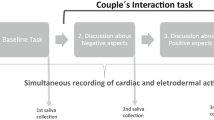Abstract
Systolic and diastolic blood pressures (SBP, DBP) were measured for 70 college students before, during and after informal dyadic conversations. Participants rated the positive and negative affect they experienced during conversation. SBP and DBP increased significantly from baseline to conversation. Increases in SBP and DBP were associated with more positive affect and unrelated to negative affect. Blood pressure measures taken one week later provided a more useful assessment of resting levels than measures taken before the conversation. Relationships between BP reactivity and positive affect remained significant after controlling for resting levels of BP, amount of talk during conversation, and sex of speaker in hierarchical regression. Blood pressure elevation during social interaction may be associated with involvement or enthusiasm, rather than emotional distress; this association is not simply an artifact of talkativeness. We suggest that cardiovascular reactivity in healthy young adults engaged in nonthreatening conversations may be a widespread phenomenon and not necessarily pathological.
Similar content being viewed by others
References
Brown, P. C., and Smith, T. W. (1992). Social influence, marriage, and the heart: Cardiovascular consequences of interpersonal control in husbands and wives.Health Psych. 11: 88–96.
Burns, J. W., and Katkin, E. S. (1993). Psychological, situational, and gender predictors of cardiovascular reactivity to stress: A multivariate approach.J. Behav. Med. 16: 445–465.
Cacioppo, J. T., Uchino, B. N., Crites, S. L., Syndersmith, M. A., Smith, G., Berntson, G. F., and Lang, P. J. (1992). Relationship between facial expressiveness and sympathetic activation in emotion: A critical review with emphasis on modeling underlying mechanisms and individual differences.J. Personal. Soc. Psychol. 62: 110–128.
Chesney, M. A., and Rosenman, R. H. (1985).Anger and Hostility in Cardiovascular and Behavioral Disorders, Hemisphere, Washington, DC.
Friedmann, E., Thomas, S. A., Kulick-Ciuffo, D., Lynch, J. J., and Suginohara, M. (1982). The effects of normal and rapid speech on blood pressure.Psychosom. Med. 44: 545–553.
Gerin, W., Pieper, C., and Pickering, T. G. (1993). Measurement reliability of cardiovascular reactivity change scores: A comparison of intermittent and continuous methods of assessment.J. Psychosom. Res. 37: 493–501.
Hofer, M. A. (1984). Relationships as regulators: A psychobiological perspective on bereavement.Psychosom. Med. 46: 183–197.
Jaffe, J., and Feldstein, S. (1970).Rhythms of Dialogue, Academic, New York.
James, G. D., Yee, L. S., Harshfield, G. A., Blank, S. G., and Pickering, T. G. (1986). The influence of happiness, anger and anxiety on the blood pressure of borderline hypertensives.Psychosom. Med. 48: 502–508.
Kellermann, K., Broetzmann, S., Lim, T., and Kitao, K. (1989). The conversation MOP: Scenes in the stream of discourse.Discourse Process. 12: 27–61.
Krantz, D. S., and Manuck, S. B. (1984). Acute psychophysiologic reactivity and risk of cardiovascular disease: A review and methodologic critique.Psychol. Bull. 96: 935–464.
Linden, W. (1987). A microanalysis of autonomic activity during human speech.Psychosom. Med. 49: 562–578.
Linden, W. (1988). Computerized cardiovascular monitoring: Method and data.Psychophysiology 25: 227–234.
Linden, W., and McEachern, H. M. (1985). A review of physiological prestress adaptation: Effects of duration and context.Int. J. Psychophysiol. 2: 239–245.
Lynch, J. J. (1985).The Language of the Heart: The Body's Response to Human Dialogue, Basic Books, New York.
Lynch, J. J., Thomas, S. A., Long, J. M., Malinow, K. L., Chickadonz, G., and Katcher, A. H. (1980). Human speech and blood pressure.J. Nervous and Mental Disorders 168: 526–534.
Mooney, K. (1989). Assertiveness, family history of hypertension, and other psychological and biophysical variables as predictors of cardiovascular reactivity to social stress. Unpublished doctoral dissertation, University of New Hampshire, Durham.
Schneiderman, N., Tischenkel, N., and Nelesen, R. (1986). Anger, aerobics and autonomic reactivity. In Schmidt, T. H., Dembroski, T. M., and Blumchen, G. (eds.),Biological and Psychological Factors in Cardiovascular Disease. Springer Verlag, New York.
Siegman, A. W., Anderson, R. A., and Berger, T. (1990). The angry voice: Its effect on the experience of anger and cardiovascular reactivity.Psychosom. Med. 52: 631–643.
Smith, T. W. (1992). Hostility and health: current status of a psychosomatic hypothesis.Health Psych. 11: 139–150.
Smith, T. W., and Allred, K. D. (1989). Blood-pressure responses during social interaction in high- and low-cynically hostile males.J. Behav. Med. 12: 135–143.
Warner, R. M., Malloy, D., Schneider, K., Knoth, R., and Wilder, B. (1987). Rhythmic organization of social interaction and observer ratings of positive affect and involvement.J. Nonverb. Behav. 11: 57–74.
Watson, D., Clark, L. A., and Tellegen, A. (1988). Development and validation of brief measures of positive and negative affect: The PANAS scales.J. Personal. Soc. Psychol. 54: 1063–1070.
Wesseling, K. H., Settels, J. J., and de Wit, B. (1986). The measurement of continuous finger arterial pressure noninvasively in stationary subjects. In Schmidt, T. H., Dembroski, T. M., and Blumchen, G. (eds.),Biological and Psychological Factors in Cardiovascular Disease, Springer Verlag, New York.
Author information
Authors and Affiliations
Rights and permissions
About this article
Cite this article
Warner, R.M., Strowman, S.R. Cardiovascular reactivity and positive/negative affect during conversations. J Behav Med 18, 141–159 (1995). https://doi.org/10.1007/BF01857866
Accepted:
Issue Date:
DOI: https://doi.org/10.1007/BF01857866



